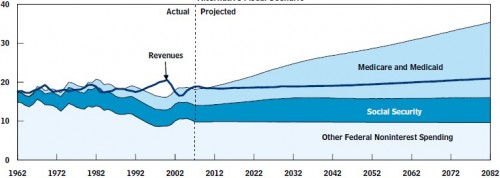If you’re looking for two different perspectives on the House Republicans’ “Pledge to America,” to be officially unveiled later today, see Ezra Klein and Avik Roy. For a concise summary of what’s in it on health care and how it relates to current law, see Igor Volsky. I want to focus on just one thing, and it isn’t really about the Pledge, though it relates to something Avik wrote in reaction to it.
Importantly, the Pledge says almost nothing about the biggest and most difficult questions in health policy: Medicare and Medicaid reform. It criticizes PPACA’s “massive Medicare cuts” without offering an alternative solution for putting the program on stable long-term footing.
If there is one thing I would love for all Americans to have in mind when evaluating politicians’ pronouncements about what we have done or should do with respect to government health spending it is this graph of projected federal revenue and spending as a percent of GDP, from the CBO:
There can be no mistaking that Medicare and Medicaid spending are the major problem and that they are a big problem. Now, the content of this graph is based on a 2008 projection, which precedes the new health reform law (the ACA). The ACA will make some cuts in Medicare growth, expected to save about $416 billion dollars over ten years. Ten years of Medicare spending comes to $7 trillion dollars. So, the ACA’s reduction is about 6%. Is that “massive”?
Well, even if one wishes to argue that a 6% cut over ten years in a runaway program is “massive,” the fact remains that massively more is needed. Of course I hope that every American could understand this, but I know that is too much to ask. I would think congressional leaders of both parties would understand this. They should. It’s their job.
When I read that the House leadership of one party has no plan for the future of spending by public health programs and the other party has done its best and can only find a way to a 6% adjustment, I want to laugh, I probably should cry, but all I can do is shake my head. Too bad two or more wrongs don’t make a right. Really, they just make a costly mess.
Is the graph above really so hard to understand?
(Insert usual disclaimer about how politics impose constraints on what can be done. Nevertheless, we’ve got to at least talk as if we know what the problem is, even if we can’t solve it right now.)



